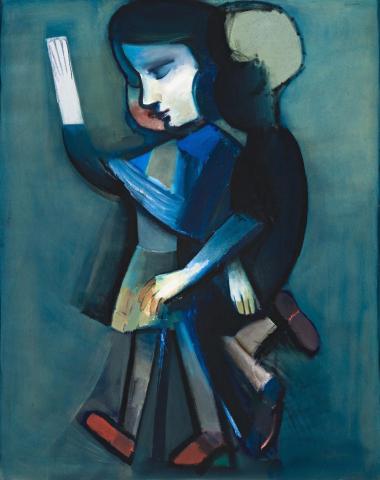ILLUSION OF CHILDREN, c.1965
CHARLES BLACKMAN
oil on composition board
159.0 x 124.0 cm
signed upper right: BLACKMAN
signed and inscribed with title on label attached verso: “An Allusion [sic.] to/ Children”./ Charles Blackman
Leonard Joel, Melbourne, 25 July 1984, lot 310
Private collection, Victoria
Illusion of Children I, oil on canvas, 155.0 x 195.0 am, in Charles Blackman: New Paintings, South Yarra Gallery, Melbourne, 29 March - 22 April 1966, cat.19
Awarded the prestigious Helena Rubinstein Travelling Scholarship in 1960, Blackman subsequently moved with his family to London where he lived and worked from 1961 to 1966. During these years of great stimulus and discovery, he not only made the acquaintance of many new and important friends, including Ted Hughes, Sylvia Plath, Al Alvarez and Barry Humphries, but equally, was afforded the unique opportunity to engage with a much wider sphere of art than previously possible - from Byzantine and Renaissance through to contemporary British movements such as Pop and Op art. Not surprisingly perhaps, his monumental paintings from this period were acclaimed among the most accomplished and challenging of his entire career; as Bryan Robertson observed of the series exhibited at Matthiesen Gallery in 1961, '...these are some of the strongest, most urgent and forceful paintings by a young artist that I have seen in the past ten years. Part of their essential character springs from the interpretation, marvellously developed and sustained, between the tenderness and grace of the personages contained in the paintings and the fiercely, implacably controlled means taken to give these personages life and eloquence...'1
Belonging to the series of works on the theme of children playing which Blackman executed during his London years, Illusion of Children accordingly betrays a myriad of artistic influences. The sumptuous palette of rich scarlet red and ultramarine blue, together with the cropping and overlapping of figures unmistakably recalls Titian and the grand manner of Venetian painting which Blackman had experienced for the first time at the National Gallery, London; the sense of immediacy and domination of the canvas by the human frame bears affinities with the work of his British contemporary Francis Bacon, while the accumulation of reiterated images is strongly evocative of the 'variation' - that quintessential motif of twentieth-century music and literature.
As with closely related images such as Cul de Sac and The Footballer, the present work does not explore the rough and tumble of childhood, but rather, is imbued with the artist's impeccable sense of lyricism, suggesting the growing perceptions, emotions and dreams of children. As poet Judith Wright reflected in the exhibition catalogue accompanying the inaugural display of selected works from this series in Australia at the Johnstone Gallery in 1963: '...These faces, hands and figures seen obliquely through rain-washed windows, or half-closed eyelashes, caught in moments of forgetfulness, and always conscious of being observed, are drawings with a new sureness and swiftness. Pictures of innocence or of experience, they always illuminate their subject. The insights they give us are inherent in Blackman's special way of looking at his world.'
1. Robertson, B., 'Preface', Charles Blackman, Matthiesen Gallery, London, November 1961, n.p.
2. Wright, J., 'Preface', Blackman: Paintings & Drawings, The Johnstone Gallery, Brisbane, 2 - 18 April 1963, n.p.
VERONICA ANGELATOS
